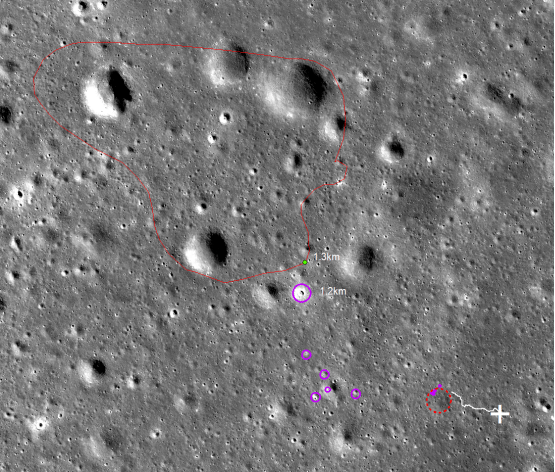
[ad_1]
Original title: Chang’e 4 completed its 23rd day of work for the 13th anniversary of the release of Chang’e 1 Source: The Paper
The WeChat public account of the “China Lunar Exploration Project” reported on October 24 that with the movement of the celestial bodies, night fell again on the back of the moon. The Chang’e 4 lander and the “Yutu 2” lunar rover completed on the 23rd of the month. At 21:40 and 12:00 on October 23, they completed the lunar night mode setting in accordance with ground instructions. and went into a lunar night dream. To this day, the Chang’e-4 lander and the “Yutu-2” lunar rover have worked successfully on the back of the moon for 660 Earth days, traveling a total of 565.9 meters.

Recent basalt coverage area (red line area)
According to the data from the images joined by the panoramic camera and the DOM images on the 22nd, the lunar rover “Yutu-2” traveled to the basalt distribution area and the impact crater area with the highest reflectivity on the 23rd. Both locations are located northwest of the moon rover. On this path of travel, the infrared imaging spectrometer made a spectral detection of a rock block with a diameter of approximately 30 cm. The scientific research team is conducting in-depth research on the detection data.
During 23 months of scientific exploration, the lander’s lunar surface neutron and radiation dose detector carried out the first detection of the ground particle radiation environment in situ on the lunar surface and obtained valuable scientific data. first hand. The results of the research are in the published Science Advance Journal.

The installation position of the lunar surface neutron and radiation dose detector on the lander
The lunar surface neutron and radiation dose detector can comprehensively measure total particle radiation dose, neutral particle radiation dose, LET spectrum of particle radiation, neutrons and charged particles on the surface of the moon. The actual measurement results show that the particle radiation dose rate near the landing zone is 13.2uGy / h (yes), the equivalent dose is twice the surface of Mars and the interior of the space station, 5 to 10 times of a flight and 300 times of the surface of the earth (Beijing).

The measured monthly radiation dose (the horizontal axis is universal time, the vertical axis are respectively: a total radiation dose rate in silicon (microGray / hour), b. Neutral particle radiation dose rate in silicon (microGray ) / Hour), c. The radiation dose rate of silicon charged particles (microGray / hour), d. The flux of penetrating cosmic ray particles (pieces / square centimeter · hour · radians)
The results of these field measurements provide important radiation environmental parameters for follow-up lunar exploration in China. The charge also distinguishes the radiation dose of charged particles and neutral particles, thus providing more precise physical amounts of radiation, which can serve for the radiological protection of future astronauts.
Today in the history of space flight:
On October 24, 2007, China’s first lunar exploration satellite, Chang’e-1, was successfully launched by the Long March 3A carrier rocket at the Xichang Satellite Launch Center, opening the glorious course of the project of lunar exploration of China. On November 12, 2008, the full moon image taken by Chang’e-1 was released. On March 1, 2009, the satellite struck the moon in a controlled manner as scheduled. The successful implementation of this mission marked China’s entry into the world’s deep space exploration club and established the third milestone of China’s space flight after artificial satellites and manned space flight.

On October 24, 2014, China’s first-month high-speed reentry aircraft was launched from the modified carrier rocket II on C Long March III at the Xichang Satellite Launch Center, and orbited the moon three days later. On November 1, the returnee landed in Siziwang Banner, Ulanqab City, Inner Mongolia, China. As a pilot mission for the third phase of the lunar exploration project, it verified key lunar sampling and return technology, laying a solid foundation for lunar sampling and return.
 Schematic diagram of the reentry and return test track
Schematic diagram of the reentry and return test track